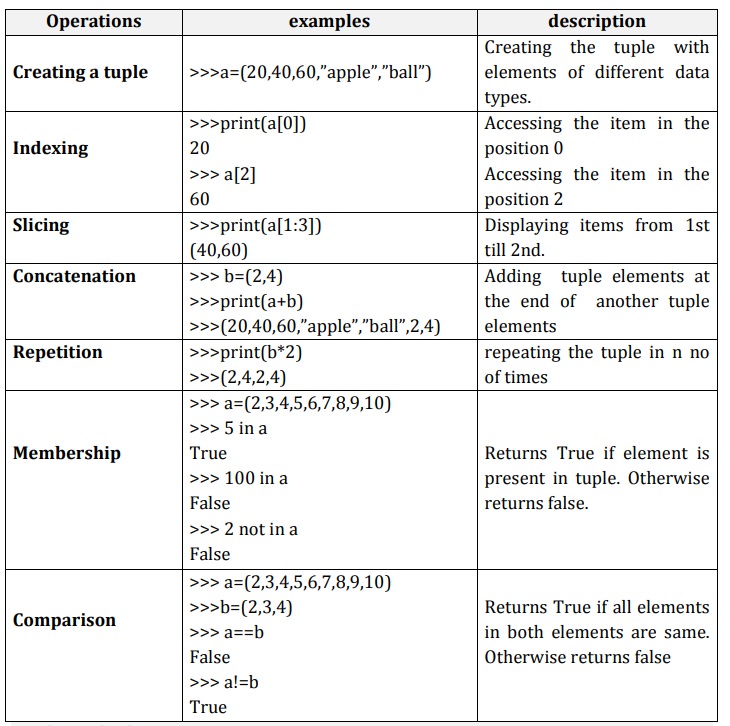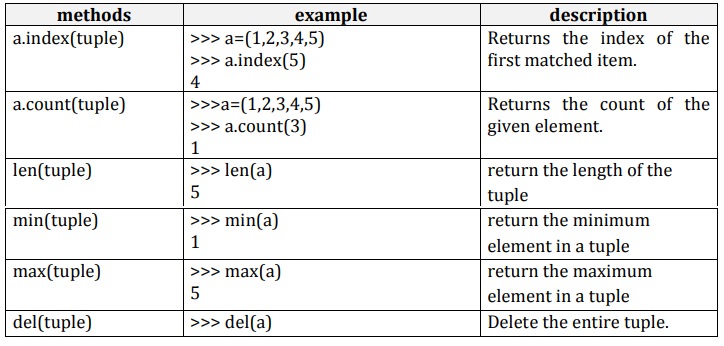Chapter: Problem Solving and Python Programming : Lists, Tuples, Dictionaries
Tuple - Python
Tuple:
v A tuple is same as list, except that the set
of elements is enclosed in parentheses instead of square brackets.
v A tuple is an immutable list. i.e. once a
tuple has been created, you can't add elements to a tuple or remove elements
from the tuple.
v But tuple can be converted into list and list
can be converted in to tuple.

Benefit of Tuple:
v Tuples are faster than lists.
v If the user wants to protect the data from
accidental changes, tuple can be used.
v Tuples can be used as keys in dictionaries,
while lists can't.
Operations on Tuples:
1.
Indexing
2.
Slicing
3.
Concatenation
4.
Repetitions
5.
Membership
6.
Comparison

Tuple methods:
Tuple is
immutable so changes cannot be done on the elements of a tuple once it is
assigned.

Tuple Assignment:
v Tuple assignment allows, variables on the left
of an assignment operator and values of tuple on the right of the assignment
operator.
v Multiple assignment works by creating a tuple
of expressions from the right hand side, and a tuple of targets from the left,
and then matching each expression to a target.
v Because multiple assignments use tuples to
work, it is often termed tuple assignment.
Uses of Tuple assignment:
v It is often useful to swap the values of two
variables.
Example:
Swapping using temporary variable:
a=20
b=50
temp = a
a = b
b = temp
print("value
after swapping is",a,b)
Swapping using tuple assignment:
a=20
b=50
(a,b)=(b,a)
print("value
after swapping is",a,b)
Multiple assignments:
Multiple values
can be assigned to multiple variables using tuple assignment.
>>>(a,b,c)=(1,2,3)
>>>print(a)
1
>>>print(b)
2
>>>print(c)
3
Tuple as return value:
v A Tuple is a comma separated sequence of
items.
v It is created with or without ( ).
v A function can return one value. if you want
to return more than one value from a function. we can use tuple as return
value.
Example1:
def div(a,b):
r=a%b
q=a//b
return(r,q)
a=eval(input("enter a value:"))
b=eval(input("enter b value:"))
r,q=div(a,b)
print("reminder:",r)
print("quotient:",q)
Output:
enter a value:4
enter b value:3
reminder: 1
quotient: 1
Example2:
def min_max(a):
small=min(a)
big=max(a)
return(small,big)
a=[1,2,3,4,6]
small,big=min_max(a)
print("smallest:",small)
print("biggest:",big)
Output:
smallest: 1
biggest: 6
Tuple as argument:
The parameter
name that begins with * gathers argument into a tuple.
Example:
def
printall(*args):
print(args)
printall(2,3,'a')
Output:
(2, 3, 'a')
Related Topics